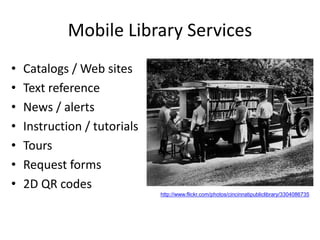M Health Sciences Libraries
- 1. M-Health Sciences Libraries Eric Schnell Midwest Chapter Medical Library Association Columbus, OH October 5, 2009 http://www.flickr.com/photos/fr3d/2660915175/
- 5. Pew Research: 2009 • 56% of adult Americans have accessed the internet by wireless means • 32% have used a mobile phone to access the internet • On a typical day, 19% of Americans use the internet on a mobile device • 17% of Americans have used other access devices – iPods, game consoles, or e-books http://www.pewinternet.org/Reports/2009/12-Wireless-Internet-Use.aspx
- 10. Mobile Library Services • Catalogs / Web sites • Text reference • News / alerts • Instruction / tutorials • Tours • Request forms • 2D QR codes http://www.flickr.com/photos/cincinnatipubliclibrary/3304086735
- 12. University of Wisconsin-Madison Ebling Library http://m.ebling.library.wisc.edu
- 13. Boston University Medical Center http://med-libwww.bu.edu/mobile/
- 18. National Library of Health Sciences Terkko http://www.terkko.helsinki.fi/english/mobile/articlerequest.php
- 19. QR Codes
- 21. DOI: 10.1007/b12029 University of Oulu, Finland
- 23. Microsoft “Courier” / Apple Tablet http://gizmodo.com/5365299 http://images.brisbanetimes.com.au/2009/08/26/6 98970/420appletablet_imagined-420x0.jpg
- 24. Present Challenges • Device platforms • Redesigning sites • Database interfaces • Document viewers • Multimedia support http://www.flickr.com/photos/kecko/158953624
- 25. Supporting Mobile Users • What products and/or services should we be providing? • What mobile services make sense for a library to implement? • What should mobile-friendly content look like? • How should we provide mobile access to existing content?
- 26. Supporting Mobile Users Baby Steps • WiFi access • Power / Battery recharging stations • Infrared services • Identify/organize mobile-ready content http://www.flickr.com/photos/rudiriet/109718325
- 27. Keeping Up With Mobile http://www.libsuccess.org
- 29. QuickTime™ and a TIFF (Uncompressed) decompressor are needed to see this picture. http://siue.libguides.com/mobile
Editor's Notes
- Everyone stand if you own a: Kindle Netbook computer Laptop computer Portable media player or PDA with WiFi (e.g. iPod Touch) iPhone or other Smart Phone Cell Phone with a simple Web Browser
- Those of you still sitting, these two guys have more mobile technology then you do.
- In health care, mobile technology has been embraced bedside
- There are numerous health care applications available for mobile devices
- There are numerous health care applications available for mobile devices
- There are numerous health care applications available for mobile devices
- So, what kinds of mobile services should medical libraries be thinking about?
- One quick way to support mobile users is to create a page on your existing Web site which lists existing resources and services
- A fully mobile version of your Web site will require a separate design. If your current web site is database-driven, you may be able to apply a new style sheet to generate a mobile site.
- In this example, many of the basic services including Medline, subject guides, library directory, and a basic search are built into a very concise mobile site.
- Existing Web sites and online catalogs can take advantage of some aspects of mobile services, such as sending information through text messaging.
- Library patrons with cellphone bluetooth turned on receive a message as they walk through the door of the Delft Public Library. The message says "Welcome to the most modern library in the world."
- Many libraries are publishing podcasts of instruction programs, tutorials, or tours which allow customers can download into their mobile audio players and phones.
- Some libraries have created mobile versions of their document delivery request forms.
- While conventional bar codes can store about 20 digits of information, a single QR (quick response) code is capable of handling 7,089 characters including numeric and alphabetic characters, symbols, and binary data. One can store just about anything as a QR code, including images. QR codes are quite durable since the allow up to 30% of the code to be obscured or removed by dirt, marks or damage and still readable. The nice thing is that there are many online services which generate QR codes and they can be printed as a graphic image.
- Geolocation is the identification of the real-world geographic location of an Internet-connected computer, mobile device, website visitor or other. While knowing that you can be located through your device sounds big-brother, geolocation could help in providing library services.
- When physical resources are geolocated, users could use their mobile devices to locate them.
- Augmented reality (AR) is a term for a live direct or indirect view of a physical real-world environment whose elements are merged with (or augmented by) computer-generated data overlays.
- There are still many challenges in extending library services to the mobile community
- Questions which should be asked when deciding to support mobile users
- WiFi access – Make sure you have coverage in your library Power / Battery recharging stations – some libraries use small lockers with power strips inside so users can lock in their device while it recharges. Other libraries keep a variety of chargers available for checkout. Infrared services- Many printers can support the beaming of print jobs from mobile devices. Identify/organize mobile-ready content – Much in the way that Shiffman library did in an earlier example.
- Library Successis an excellent resource for many library best practices, including mobile.
































